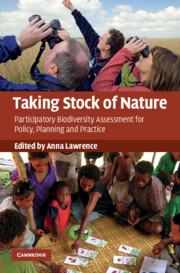Book contents
- Frontmatter
- Contents
- List of contributors
- Acknowledgements
- 1 Introduction: learning from experiences of participatory biodiversity assessment
- 2 Monitoring and assessment of biodiversity under the Convention on Biological Diversity and other international agreements
- 3 The Millennium Ecosystem Assessment: a multi-scale assessment for global stakeholders
- 4 Conservation of biological diversity in El Salvador shade coffee: the importance of taxonomic capacity for participatory assessments
- 5 Taking stock of nature in species-rich but economically poor areas: an emerging discipline of locally based monitoring
- 6 Researching local perspectives on biodiversity in tropical landscapes: lessons from ten case studies
- 7 Participatory resources monitoring in SW China: lessons after five years
- 8 Forest inventory in Nepal – technical power or social empowerment?
- 9 Perceptions of landscape change in British Columbia's Northwest: implications for biodiversity and participatory management
- 10 How thousands planned for a billion: lessons from India on decentralized, participatory planning
- 11 Inside monitoring: a comparison of bird monitoring groups in Slovenia and the United Kingdom
- 12 The personal and political of volunteers' data: towards a national biodiversity database for the UK
- 13 Improving forest management through participatory monitoring: a comparative case study of four community-based forestry organizations in the Western United States
- Index
- References
1 - Introduction: learning from experiences of participatory biodiversity assessment
Published online by Cambridge University Press: 06 December 2010
- Frontmatter
- Contents
- List of contributors
- Acknowledgements
- 1 Introduction: learning from experiences of participatory biodiversity assessment
- 2 Monitoring and assessment of biodiversity under the Convention on Biological Diversity and other international agreements
- 3 The Millennium Ecosystem Assessment: a multi-scale assessment for global stakeholders
- 4 Conservation of biological diversity in El Salvador shade coffee: the importance of taxonomic capacity for participatory assessments
- 5 Taking stock of nature in species-rich but economically poor areas: an emerging discipline of locally based monitoring
- 6 Researching local perspectives on biodiversity in tropical landscapes: lessons from ten case studies
- 7 Participatory resources monitoring in SW China: lessons after five years
- 8 Forest inventory in Nepal – technical power or social empowerment?
- 9 Perceptions of landscape change in British Columbia's Northwest: implications for biodiversity and participatory management
- 10 How thousands planned for a billion: lessons from India on decentralized, participatory planning
- 11 Inside monitoring: a comparison of bird monitoring groups in Slovenia and the United Kingdom
- 12 The personal and political of volunteers' data: towards a national biodiversity database for the UK
- 13 Improving forest management through participatory monitoring: a comparative case study of four community-based forestry organizations in the Western United States
- Index
- References
Summary
Introduction
A few years ago, curious to find out how individuals can bring about change in environmental policy, I arranged to meet volunteers who collect data about species distributions. My first interview was with a lively, successful group of volunteers in the south of England, who had developed a new approach for monitoring hedgerows. Ancient hedgerows are important for conservation in Britain, helping to maintain diversity of habitat, and connect up patches of otherwise isolated woodland. As a result of systematic surveys, some of them by volunteers, the British Government had changed the law and introduced incentives for farmers to replant them (in 1992), and regulations to protect them (in 1994).
Certainly the volunteers were enthusiastic about their successes and policy impact. But what they mostly wanted to talk about was the beauty of hedgerows, the pleasure they found in observing the variety in a line of trees, and the feeling that without the excuse of collecting data, they were being a little self-indulgent by spending time in nature. As one said, ‘It's nice, but as long as you do it with a purpose in mind and at the end of it you feel you've done something really quite good’.
Thousands of miles away, other people were collecting data about species, but these data had a more immediate effect on their lives. They were villagers in Karnataka, in southern India, who shared management of their forests with the state Forest Department.
- Type
- Chapter
- Information
- Taking Stock of NatureParticipatory Biodiversity Assessment for Policy, Planning and Practice, pp. 1 - 29Publisher: Cambridge University PressPrint publication year: 2010
References
- 4
- Cited by



